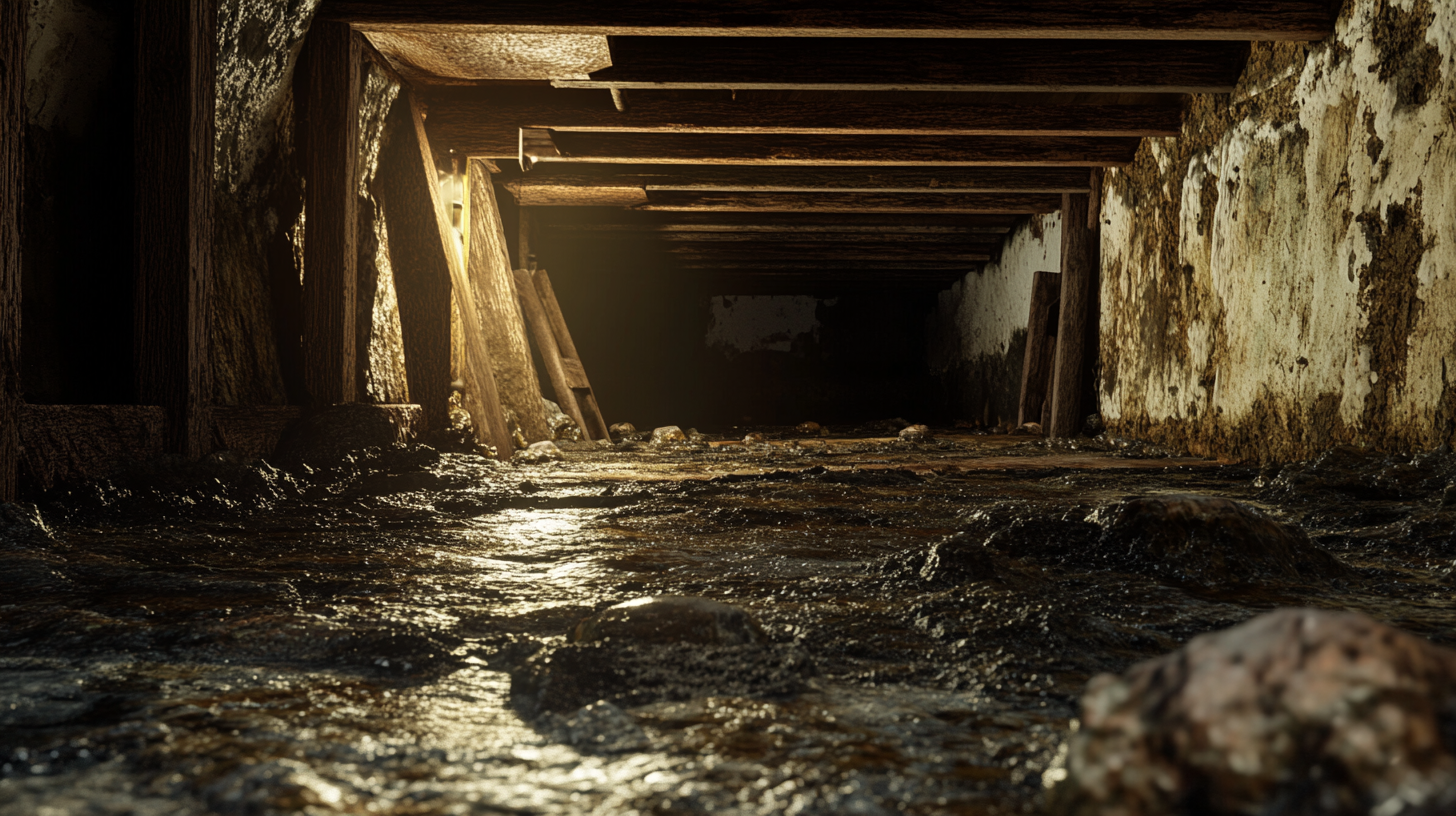Now IS THe Time To...

Crawl Space Services In Knoxville, TN
Stetson Howard: 865-432-6743
CRAWL SPACE ENCAPSULATION, REPAIR, WATERPROOFING & MOLD REMOVAL
No-Obligation, Free Inspections
No-Obligation Free Estimates
We Warranty All of Our Work
100% Satisfaction Guaranteed
In the heart of a home's defense system against the relentless assault of water damage lies a silent guardian: the sump pump. This pivotal device, often overlooked until the skies darken and the waters rise, plays a crucial role in protecting the structural integrity of our homes and the health of those who dwell within. This blog delves into the vital importance of ensuring your sump pump is in optimal working condition, ready to stand guard against the potential devastation brought on by flooding.
Water has a way of finding its path into our basements and crawl spaces, whether through heavy rainfall, melting snow, or rising groundwater levels. Left unchecked, this intrusion can lead to costly repairs, irreplaceable damage to personal belongings, and the growth of mold and mildew that pose serious health risks. Here, the sump pump emerges as a key player in home water management, actively removing accumulated water and directing it away from our homes, thus maintaining the dryness and safety of our living spaces.
The significance of a properly functioning sump pump extends beyond the immediate prevention of water pooling. It encompasses the preservation of our home's foundation, the protection of its structural elements, and the prevention of conditions conducive to mold and mildew growth. Moreover, in areas prone to frequent or severe flooding, a reliable sump pump can mean the difference between a minor inconvenience and a major disaster.
As we explore the intricacies of sump pump maintenance, the signs of potential issues, and the steps homeowners can take to ensure their system's reliability, this blog aims to highlight the indispensable role of the sump pump. Whether you're a seasoned homeowner or new to the responsibilities of home maintenance, understanding the critical importance of a properly functioning sump pump is essential for safeguarding your home against the challenges posed by water damage.
Recognizing the Signs of Sump Pump Issues
A sump pump stands as a vigilant protector of your home, tirelessly working to prevent water damage and maintain the integrity of your property's foundation. However, like any mechanical device, it can encounter issues that hinder its performance. Recognizing the signs of potential sump pump problems is crucial for timely intervention, ensuring your home remains dry and secure. This section outlines common symptoms of sump pump issues and explains the implications these symptoms may have on the pump's performance and lifespan.
Identifying Common Symptoms
List of Signs Indicating Potential Sump Pump Problems
- Unusual Noises: Grinding, rattling, or gurgling sounds can indicate a problem with the pump's motor or impeller, suggesting an obstruction or wear.
- Continuous Operation: If the pump runs non-stop, it may be struggling to manage water levels, possibly due to an incorrect size, a stuck switch, or a malfunctioning check valve.
- Failure to Start: A sump pump that doesn't activate in the presence of water might have electrical issues, a faulty switch, or be at the end of its operational life.
- Intermittent Cycling: Frequent on-and-off cycling, even in dry conditions, could signal a faulty float switch or a problem with the pump's settings.
- Visible Rust: Rust formation can compromise the pump's structure and functionality, potentially leading to leaks or failure.
- Water Ejection Issues: If the pump seems to be working but water isn't being expelled efficiently, the discharge line may be blocked or damaged.
Understanding the Implications
Explanation of How These Symptoms Can Affect the Performance and Lifespan of the Sump Pump
Each of these symptoms not only signals a need for immediate attention but also has broader implications for the sump pump's performance and longevity:
- Unusual noises often precede significant mechanical failures, which can leave your home unprotected during critical times.
- Continuous operation and intermittent cycling put undue stress on the pump's motor, hastening wear and potentially leading to premature failure.
- Failure to start in the presence of water risks immediate flooding, highlighting the importance of regular testing and maintenance.
- Visible rust and water ejection issues compromise the system's integrity, reducing its efficiency and increasing the risk of water damage to your home.
Recognizing and addressing these symptoms promptly can prevent costly repairs, extend the lifespan of your sump pump, and ensure it continues to provide reliable protection against flooding.
Common Issues and Troubleshooting Steps
A sump pump is an essential component of a home's water management system, designed to protect the property from flooding and water damage. However, like any mechanical device, it can encounter issues that affect its operation. Understanding how to troubleshoot common problems can help homeowners quickly restore their sump pump's functionality. This section covers troubleshooting steps for when a sump pump won't start or stops working, runs continuously, or produces excessive noise or vibrations.
Sump Pump Won't Start or Stops Working
Possible Causes and Step-by-Step Troubleshooting Guide
- Power Supply Issues: Check if the pump is plugged in, the outlet is functional (test with another device), and the circuit breaker hasn't tripped. Ensure any GFCI outlet hasn't been tripped.
- Float Switch Problems: Verify that the float switch is not obstructed and can move freely. Adjust the position of the pump or float switch if necessary to ensure proper activation.
Troubleshooting Steps:
- Confirm power supply to the pump and reset any tripped GFCI outlets or circuit breakers.
- Inspect and clear any debris obstructing the float switch.
- Test the pump by manually lifting the float switch to see if it activates.
Sump Pump Runs Continuously
Potential Reasons and Solutions
- Incorrect Size: A pump that's too small may run continuously to keep up with water flow. Consider upgrading to a pump with a higher capacity.
- Stuck Switch: A float switch that's stuck in the "on" position can cause continuous operation. Clean and adjust the switch, or replace it if damaged.
- Continuous Water Flow: High water table or heavy rain can lead to non-stop operation. Ensure proper drainage around your home and consider a secondary backup pump for heavy flow conditions.
Solutions:
- Assess and upgrade the pump size if necessary.
- Clean, adjust, or replace the float switch.
- Improve exterior drainage and consider additional sump pump solutions.
Excessive Noise or Vibrations
Common Causes and Solutions
- Damaged Impeller: A broken or obstructed impeller can cause noise. Inspect and clear any debris, or replace the impeller if damaged.
- Air in the System: Air getting trapped in the pump or discharge line can lead to noisy operation. Check for leaks in the intake or discharge lines and ensure they're sealed properly.
How to Diagnose and Fix:
- Disconnect the pump and inspect the impeller for damage or blockages.
- Check the system for air leaks and ensure all connections are tight and sealed.
Addressing Discharge Pipe Problems
A sump pump's efficiency is not only determined by its ability to pump out water but also by the condition of its discharge pipe. Problems like clogs, freezing, or leaks in the discharge pipe can significantly hinder the system's performance, potentially leading to water damage. This section offers guidance on identifying and resolving issues with clogged or frozen discharge lines, as well as detecting and sealing leaks, ensuring your sump pump system operates optimally.
Clogged or Frozen Discharge Lines
Tips for Identifying and Clearing Blockages
Clogged or frozen discharge lines can prevent water from being expelled from your basement, causing the sump pump to work harder and increasing the risk of overflow. Signs of a blockage include water backing up into the sump pit or the pump running more frequently without lowering the water level.
Clearing Blockages:
- Disconnect the pump and inspect the discharge line for visible blockages near the exit point.
- Use a plumber's snake to clear clogs within the pipe.
- For frozen lines, safely apply heat to the affected area with a heat tape or portable heater to thaw the pipe.
Preventative Measures:
- Insulate your discharge pipes to prevent freezing in cold weather.
- Install a grated discharge line opening to prevent debris and animals from entering.
- Regularly inspect and clean the discharge line to prevent clogs.
Leaks in the Discharge Pipe
How to Locate Leaks and Effective Methods for Sealing Them
Leaks in the discharge pipe can reduce the sump pump's effectiveness and lead to water damage. To locate leaks, inspect the length of the discharge pipe for wet spots, drips, or signs of water damage.
Sealing Leaks:
- For minor leaks, clean the area around the leak and apply waterproof sealant or epoxy.
- For larger leaks or damage, replace the affected section of the pipe. Ensure all connections are secure and sealed with PVC cement or appropriate connectors.
- Regularly check pipe joints and fittings for signs of wear or looseness that could lead to leaks.
Maintenance Tips to Prevent Future Issues
A well-maintained sump pump is the cornerstone of effective home water management, especially in areas prone to heavy rainfall or flooding. Regular maintenance not only extends the lifespan of your sump pump but also ensures it remains ready to protect your home from water damage at a moment's notice. This section provides a comprehensive checklist for routine cleaning and inspection, along with guidelines for testing your sump pump system, helping you maintain its efficiency and reliability.
Regular Cleaning and Inspection
Checklist for Routine Sump Pump and Sump Pit Maintenance
To keep your sump pump operating smoothly, incorporate the following tasks into your regular maintenance routine:
- Inspect the Sump Pit: Remove any debris, stones, or sediment that could obstruct the pump's intake or the float mechanism. A clean pit helps prevent clogs and ensures proper operation.
- Check the Pump and Float Switch: Ensure the pump sits upright and the float switch moves freely without obstruction. This prevents the pump from tilting and ensures the switch activates the pump at the correct water level.
- Clean the Pump Inlet Screen: Regularly clean the pump's inlet screen or filter to remove any debris that could impede water flow.
- Inspect Discharge Pipes: Check for any signs of leakage, blockage, or damage. Ensure the discharge line is securely attached to the pump and directs water away from your home's foundation.
Testing the Sump Pump System
Guidelines for Regular Testing to Ensure Readiness for Heavy Rain or Melting Snow
Testing your sump pump system regularly is crucial to ensure it's prepared for adverse weather conditions:
- Monthly Testing: Pour a bucket of water into the sump pit to raise the water level and trigger the pump. This simple test helps verify that the pump activates, runs smoothly, and efficiently drains the water.
- Check Battery Backup: If your system includes a battery backup, test it monthly by unplugging the primary pump and ensuring the backup system activates automatically.
- Annual Professional Inspection: Consider having a professional inspect your sump pump system annually. They can perform a comprehensive check, including testing backup systems, checking electrical components, and ensuring the system is optimized for your home's specific needs.
Enhancing Sump Pump Reliability
Ensuring the reliability of your sump pump is paramount to maintaining a dry and safe basement, especially during seasons prone to heavy rainfall or snowmelt. Enhancements like integrating backup solutions and installing water alarms can significantly bolster your sump pump's effectiveness. Additionally, recognizing when it's time to upgrade your sump pump can prevent potential failures and water damage. This section explores the benefits of backup systems and water alarms and discusses signs indicating the need for a sump pump upgrade.
Backup Solutions and Alarms
Overview of Battery Backup Systems and Water Alarms as Additional Safeguards
- Battery Backup Systems: A battery backup sump pump provides an essential layer of protection during power outages, a common occurrence during severe storms. These systems automatically kick in when the primary pump loses power, ensuring continuous operation and protection against flooding.
- Water Alarms: Installing water alarms near your sump pit can alert you to rising water levels before they become problematic. Early detection allows you to address issues promptly, potentially avoiding flooding and water damage.
Incorporating these safeguards enhances your sump pump system's reliability, offering peace of mind and additional protection for your home.
Upgrading Your Sump Pump
Signs That It Might Be Time to Upgrade to a Newer, More Reliable Model
Upgrading your sump pump can significantly improve your home's water management system's efficiency and reliability. Here are signs that it might be time for an upgrade:
- Frequent Malfunctions: If your sump pump frequently requires repairs or fails to activate, it may be nearing the end of its useful life.
- Insufficient Capacity: If your current pump struggles to keep up with water inflow during heavy rains, upgrading to a model with a higher capacity can provide better protection.
- Age: Sump pumps typically have a lifespan of 7-10 years. If yours is approaching or has surpassed this range, consider upgrading to a newer model with advanced features and improved efficiency.
- Lack of a Backup System: If your current setup lacks a battery backup system, upgrading to a model that includes or supports a backup can enhance your home's protection against power outages and pump failures.
FAQs
Recent Blog Posts
Crawl Space News







